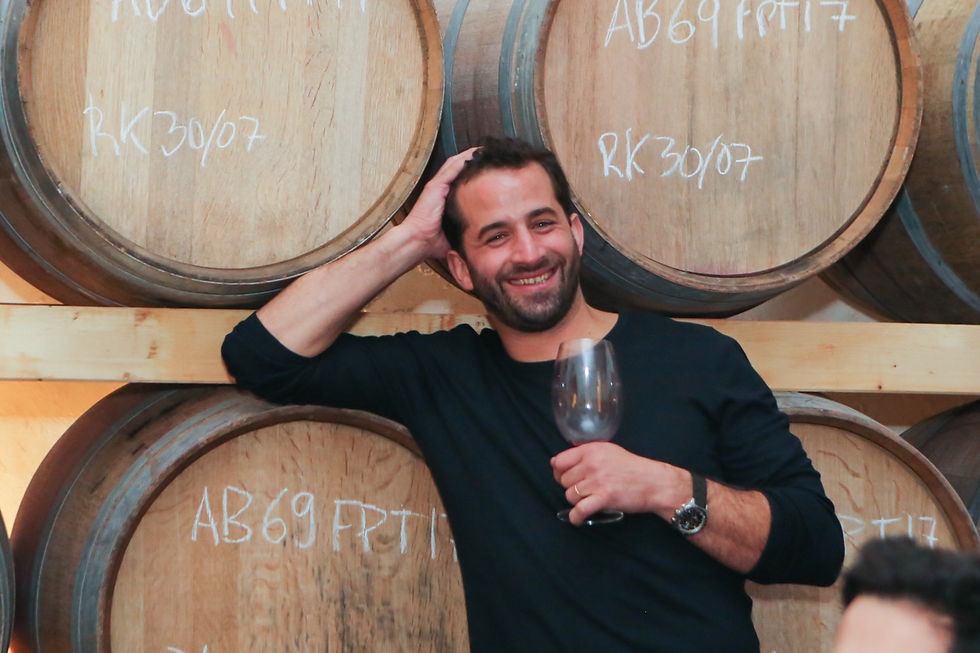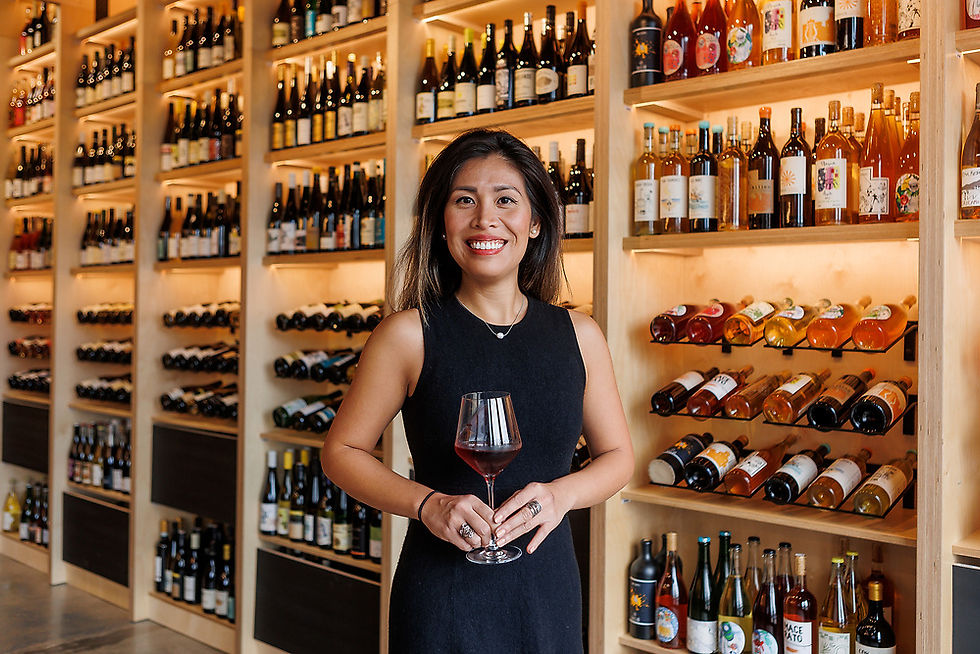Sommeliers and Restaurants, a Complimentary Pairing
- eileen strauss
- Apr 28, 2023
- 6 min read

Good food and wine on their own are pleasurable, but when they come together, something magical happens.
Like a chef, a restaurant’s sommelier has the power to elevate and add an element of sophistication to the overall dining experience. When the sommelier and the chef act as a team, the sum can be far greater than the individual parts, enhancing guest satisfaction, boosting a restaurant’s reputation, and increasing revenue.

What is a sommelier?
A sommelier is a trained and knowledgeable wine professional, typically working at an upscale or fine dining restaurant. Sommeliers are responsible for every aspect of the wine service, from the creation of the restaurant wine list to engaging with patrons.
Sommelier culture has blossomed in the past 15 years in the United States. Similar to the way chefs have begun to come out of the kitchen to enjoy a degree of celebrity, the sommelier is considered an integral important part of the restaurant experience with a personality of their own.
No longer considered a luxury employee, the sommelier is a totally integrated staff member with specialized skills. There are many important aspects to the sommelier’s role, but one of the most overlooked is their skill in wine and food pairing. Chefs often do not realize that a dish can be misunderstood simply because it is paired with the wrong wine. Few people other than a trained sommelier realize quite how this affects the customer’s taste perception.
Like a barista, fine dining establishments have recognized the importance of adding a sommelier to the mix, but more and more casual restaurants are also beginning to see the benefits of bringing a wine specialist on board. Though it is possible to hire wait staff with knowledge and experience managing the wine sector of your business, a trained sommelier brings professional know-how, unique style, and the potential to generate extra revenue.

Why should your restaurant hire a sommelier?
By hiring a sommelier, you not only add a layer of expertise and sophistication to your restaurant, but a trained sommelier is able to look at your current wine list and help you improve it, educate servers on the finer points of service and wine language, and work with your chef to create complimentary menu suggestions.
One of the more important contributions of a sommelier is that they can share their wealth of knowledge with your chef, bartenders, and wait staff. A well-educated FOH staff is better equipped to make suggestions and upsell higher-profit-making wines to your guests. By elevating the depth of knowledge of your entire staff, you can bring the best dining experience to your guests.
Characteristics of a good sommelier
1. Excellent Communication Skills
A sommelier must be able to communicate effectively with your entire staff, from front-of-house and back-of-house to, most importantly, your customers. As important as it is for them to have the knowledge you seek, they must also be able to effectively express that knowledge in a way that is effective and relatable.
Not only do sommeliers need to be skilled in explaining the nuances of wine flavors and aromas, but they also need to be able to understand what each customer is seeking by asking the right questions and translating answers into recommendations.
Comfortable coming out into the dining room and sharing their wisdom, being personable is one of the most important attributes of an effective sommelier.
2. Vast Knowledge of Food
Not only does a sommelier need to have a profound knowledge of wines, they also need to understand foods. This includes specialty foods such as cuisine from different regions worldwide in order to be able to suggest complementary food-wine combinations.
3. Open to Learning
A sommelier should have some managerial experience within a restaurant environment or be willing to learn. Managing the wine operation does not happen in a vacuum, so the wine specialist must be open to learning about all aspects of the business.
4. Understanding Wine Production Technicalities and Trends
From how different soils affect the end product to how different grapes are combined, the technicalities behind wine production are important for a sommelier to understand.
Many sommeliers travel to other areas of the world to tour vineyards and see the production process up close. Attending wine tastings is also of integral importance.
Constantly staying on top of trends in the industry and bringing that knowledge into the restaurant is also necessary for a sommelier to do a great job keeping your business growing.
5. Willing to Share Insights
A sommelier should be willing and excited to share knowledge with the wait staff, chef, and management. The entire staff should work as a team to bring the best dining experience to your guests, which means that servers should also be educated on wine and food pairings.
A sommelier should be able to help patrons feel comfortable with tasting wines and help them choose a delicious wine within their price range. Training sessions with wait staff to help them feel comfortable with reading customers and making appropriate suggestions are excellent ways to improve a restaurant’s wine service strategy.
As much as professional wine stewards can act as teachers, a good sommelier can gain invaluable insight by listening to the opinions of customers and incorporating feedback from staff.

Key sommelier responsibilities
Creating wine lists
Understanding food and wine pairings
Assisting chef with menu selections
Managing wine cellar
Ordering wine
Educating food and bar servers/bartenders
Engaging with guests
Keeping up with industry trends

How the sommelier and chef work together
The best dining experiences come from teamwork. And when the sommelier and the chef combine their knowledge about food, their experience of ingredients combinations, and their awareness of wines and beverages, the dining experience is elevated exponentially.
With guest satisfaction in mind, most sommeliers get involved with the development of the menu from the start, while successful chefs take wine into consideration when creating dishes.
The art of food pairing
As much an art as it is science, the food pairing theory says wine should be treated just like food. The guiding principle behind food pairing is to ensure guests are able to taste both the food and wine, with each complementing the other.
We’re all individuals, and our palates and personal tastes are unique, too. As such there really are no absolutely hard and fast rules when it comes to which wines go with which foods. However, there are a number of guidelines that balance flavors and can help create a great taste experience that can enhance the guest dining experience.
Wines with a higher tannin content, for example, can very often taste fairly astringent on their own, but, when matched with red meats and game with rich gravy or high cream content sauces will appear much softer and fruitier. This happens because the compounds in the tannins in red wine link with fat compounds and work together.

Grape to Glass Wine Terminology
To fully appreciate something, you need to understand it and there's plenty to learn about wine and its journey from grape to glass. When it comes to broadening your wine vocabulary, familiarizing yourself with these wine terms is certainly a good start.
Bordeaux. A region in southwest France, as well as any wine produced in this location.
Brix. The sugar content of wine grapes.
Brut. Dry wine.
Burgundy. A wine region in eastern France, as well as any wines (called Burgundies) produced there.
Cava. The Champagne of Spain, a sparkling wine.
Champagne. Sparkling wine made in the French geographical region of Champagne. Only sparkling wines produced in this specific area can be called Champagne with the uppercase “C.”
Chardonnay. A wine grape used to make Champagne and other white wines.
Corked. A cork-top wine bottle that has been tainted.
Decanting. Pouring wine from one container into another to allow the wine to aerate.
Dessert Wine. Sweet wines served with desserts - Port, Moscato, and late-harvest Riesling.
Ice wine. A sweet wine made from frozen grapes.
Dry. The opposite of sweet. (also called "brut" in French.)
Fermentation. Winemaking process that turns grape juice into alcohol.
Merlot. A black grape variety originally from the Bordeaux region of France.
Mouthfeel. The physical sensations in the mouth that wine creates.
Negociant. The French word for a wine merchant or wholesaler.
New World Wine. Wine from non-traditional wine-growing regions such as Africa, Australia, Chile, and Argentina.
Oenology. The study and science of wine and winemaking.
Oenophile. A wine lover.
Old World Wine. An umbrella term for traditional wine-growing regions in Europe, such as France, Italy, and Spain.
Pinot. French for “pine,” a black or white grape used to make Pinot Noir and Pinot Grigio.
Red Wine. A wine produced from dark-colored grapes.
Rosé Wine. Also known as blush, made from red grapes using a shorter fermentation process to produce a pink hue.
Sparkling Wine. Often used interchangeably with champagne, (with a lowercase "c”), any wine with enough carbon dioxide to make it fizzy and bubbly.
Table Wine. An affordable, everyday wine.
Tannins. Natural compounds found in wine that create an astringent, drying, and bitter flavor on the tongue.
Viniculture. The practice of cultivating grapes for winemaking.
White Wine. A wine produced from grapes that are fermented without grape skin
Wine Pairing. The art of combining food with wine
Zinfandel. A popular black-skinned wine grape variety often grown in California.
Zymology. The science of fermentation

Take Away
At the end of the day, creating wonderful meal ideas is what great dining is all about. While an establishment earns its reputation in the first instance from its food, wine completes the total guest package.
From creating a wine list and engaging with guests to educating staff and working with the chef to craft pairings, the skill of the sommelier and the essence of their role in the business brings added value to a restaurant by heightening the guest experience.
Adding a sommelier to your restaurant’s staff is a great way to make customer visits more memorable, enjoyable, and even educational, not only by offering wine suggestions that will enhance the flavor of the food but by adding a level of sophistication to the overall dining experience.

By Eileen Strauss

Comments